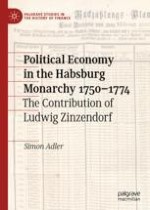2020 | OriginalPaper | Chapter
5. The Development of Zinzendorf’s Thinking on State Credit
Author : Simon Adler
Published in: Political Economy in the Habsburg Monarchy 1750–1774
Publisher: Springer International Publishing
Activate our intelligent search to find suitable subject content or patents.
Select sections of text to find matching patents with Artificial Intelligence. powered by
Select sections of text to find additional relevant content using AI-assisted search. powered by
